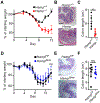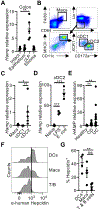Dendritic cell-derived hepcidin sequesters iron from the microbiota to promote mucosal healing
- PMID: 32273468
- PMCID: PMC7724573
- DOI: 10.1126/science.aau6481
Dendritic cell-derived hepcidin sequesters iron from the microbiota to promote mucosal healing
Abstract
Bleeding and altered iron distribution occur in multiple gastrointestinal diseases, but the importance and regulation of these changes remain unclear. We found that hepcidin, the master regulator of systemic iron homeostasis, is required for tissue repair in the mouse intestine after experimental damage. This effect was independent of hepatocyte-derived hepcidin or systemic iron levels. Rather, we identified conventional dendritic cells (cDCs) as a source of hepcidin that is induced by microbial stimulation in mice, prominent in the inflamed intestine of humans, and essential for tissue repair. cDC-derived hepcidin acted on ferroportin-expressing phagocytes to promote local iron sequestration, which regulated the microbiota and consequently facilitated intestinal repair. Collectively, these results identify a pathway whereby cDC-derived hepcidin promotes mucosal healing in the intestine through means of nutritional immunity.
Copyright © 2020 The Authors, some rights reserved; exclusive licensee American Association for the Advancement of Science. No claim to original U.S. Government Works.
Conflict of interest statement
Figures




Comment in
-
The "iron will" of the gut.Science. 2020 Apr 10;368(6487):129-130. doi: 10.1126/science.abb2915. Science. 2020. PMID: 32273453 No abstract available.
-
Ironing out the details of intestinal repair.Nat Rev Immunol. 2020 Jun;20(6):350-351. doi: 10.1038/s41577-020-0310-9. Nat Rev Immunol. 2020. PMID: 32286518 No abstract available.
-
Ironing out mucosal healing.Nat Rev Gastroenterol Hepatol. 2020 Jul;17(7):382. doi: 10.1038/s41575-020-0308-6. Nat Rev Gastroenterol Hepatol. 2020. PMID: 32350441 No abstract available.
References
Publication types
MeSH terms
Substances
Grants and funding
- 261296/ERC_/European Research Council/International
- R21 CA249274/CA/NCI NIH HHS/United States
- R01 AI145989/AI/NIAID NIH HHS/United States
- R01 AI123368/AI/NIAID NIH HHS/United States
- R01 DK126871/DK/NIDDK NIH HHS/United States
- P30 ES023515/ES/NIEHS NIH HHS/United States
- F32 AI124517/AI/NIAID NIH HHS/United States
- FS/12/63/29895/BHF_/British Heart Foundation/United Kingdom
- U2C ES030859/ES/NIEHS NIH HHS/United States
- UL1 TR002384/TR/NCATS NIH HHS/United States
- R01 AI143842/AI/NIAID NIH HHS/United States
- U01 AI095608/AI/NIAID NIH HHS/United States
- R01 AI162936/AI/NIAID NIH HHS/United States
- R00 HL125899/HL/NHLBI NIH HHS/United States
LinkOut - more resources
Full Text Sources
Medical
Molecular Biology Databases

